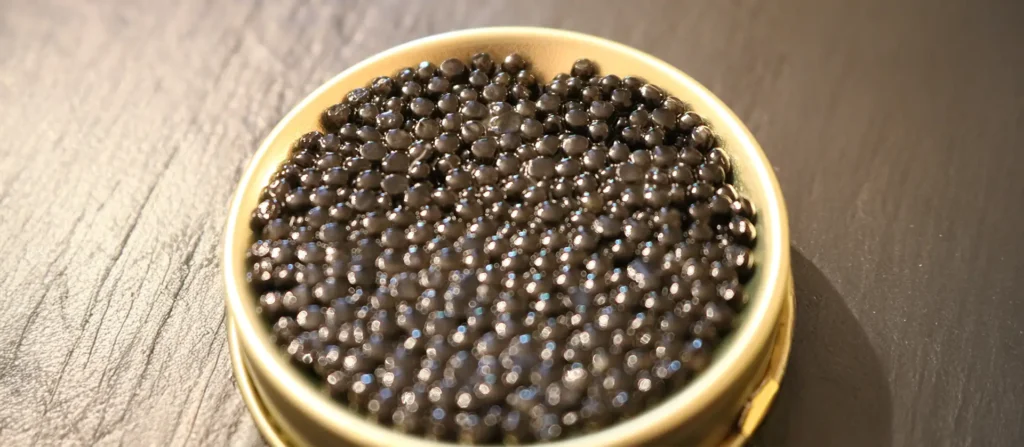Today we reveal the fundamental tips to enjoy your Ambrose & Paubet caviar to perfection, whether at home or at the restaurant. Don’t lose detail because there are HIGHLY IMPORTANT issues to make every bite an unrepeatable experience.
10 keys to serve Caviar correctly at home or in the restaurant, Madrid December 5, 2024.
Many people wonder how Caviar should be served, from Ambrose & Paubet we are going to give you some guidelines to have an excellent caviar service to enjoy our product to the maximum, both at home and in our restaurants,
Room and Kitchen Service
We can do it in different ways, the most usual ones are explained below:
- Canned dish: pilé ice and can opened in situ, as a base.
- Plating with other foods: to the kitchen’s decision. Recommendation, minimum 5-10 grams per person. Too little caviar means the risk of its flavor being hidden by the rest of the food, altering the gastronomic experience and limiting the creative use in cooking. With hot foods especially, plate at the moment of consumption.
- In bar
- Tapas: 2 to 5 gr. minimum recommended, depending on the food and/or working it alone or with tapa and beverage, or other food that is not a support (e.g. tapa + oysters + champagne, e.g. oyster as support + caviar, etc.). It is advisable to have the caviar available at the time of consumption of the tapa.
- Individual can: 10-20 grams of tasting, using the can as a support+complement, instant consumption or with pilé ice.
- Can of normal consumption per person: 20 grams minimum recommended, with glass. If for tasting, 20-30 grams for two people recommended. Pele ice base if not for immediate consumption.
- In trolley for ad-hoc consumption: recommended minimum, 20 grams per person, served in a support that keeps it cold until delivery.
- At events: ad-hoc calculation.
- In all cases, serving the product with neutral supports is important. Mother-of-pearl, good quality glass and earthenware, very pure silver and the brass of the tin itself are highly recommended. For consumption and support, it is highly inadvisable to expose the caviar to strong odors, metals (except the brass of the tin or inert metals), wood, coarse-grained glass or plastics.
In the room and in a product tasting
The usual questions, i.e. those contained in the “questions” part of this article, and also the caviar dossier attached to this document, in which they are explained, should be kept fresh:
- The importance of the first phase of production: the fry have to grow in a very quiet environment, with the most natural food possible, and therefore, exposed to the natural environment, with all that this entails. They must also grow at the correct temperatures to avoid getting sick or dying during the three phases of growth, and therefore, the trio of black caviars cannot grow in the Iberian Peninsula.
- The importance of the second phase: waiting for the right moment of extraction, is vital to be able to differentiate a genuine caviar from a poor quality product. Necessarily, caviar to be caviar, must have been extracted in the precise window of growth, that is, at the end of the yolk cycle, when the egg has developed with the help of good nutrition and without stress, the maximum size of the egg corresponding to each species, and therefore, the greatest amount of yolk, with its maximum contribution of amino acids, minerals, vitamins and collagen. In this process, how the extraction is done is equally important:
- The animal must be slaughtered quickly and painlessly to avoid hormones in the blood,
- Salt it to the microgram, depending on the species, always below 5% so that it is malossol and not a salting, and add a minimum amount of preservative (borax) (0.02%) or nothing, depending on what the customer wants.
- Subsequently, it needs to mature for 4 to 6 weeks in negative cold (i.e. the salt must break part of the collagen fibers of the outer membrane) in order to be consumed with the tenderness that each species of sturgeon must have.
* Not all collagen is equally fine, and not all caviars should “break” in the mouth, some are naturally more mellow than others.
Finally, there is the tasting phase:
- External sensory inspection (check tin, CITES, qualities) and the caviar itself, which should have a color (membrane and vitellum), smell and size in accordance with its species; the smell should also be soft. Good quality caviar is NOT black.
- First phase in the mouth. Introduce it with material as neutral as possible to avoid its “oxidation” (it binds chemically extremely quickly) on the tongue, in order to be able to observe with the tongue the firmness and the first flavor notes of the particular caviar being eaten, without breaking it.
- Second phase in the mouth: break it on the palate and taste its vitellum, which must correspond in its flavor and notes to the particular tasting of each species (see dossier).
- Third phase in throat and nose: swallow it and notice its characteristic aftertaste. This is the ideal moment to breathe it and mix it with a drink (for example).
After having done the whole cycle, the flavors change depending on the pairing and the food that binds the caviar. In any case, the taste should not be worse, but transformed and enhanced in a new, different and good set.

